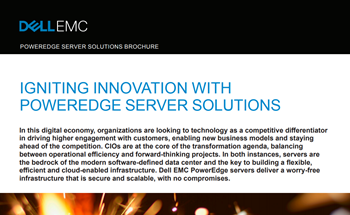There will come a time in almost every modern business' existence when the IT department will need to look into choosing a server. As companies grow, so do their computing needs, and elements such as file sharing become an issue. A server is generally the best solution, but how do you choose the right one?
This is not a decision that should be taken lightly. You don't want to go over budget purchasing a powerful server that your company doesn't need, or skimp on a model that will not be fit for purpose when the business grows again in a year's time. Either option is a waste of money and your time.
Share this Image On Your Site
To make sure you're making the right purchase, take a look at the following steps. Going through these should put you in a good position to choose the right server for your company.
Physical or cloud-based?
One of the first things you should consider is whether to purchase a physical server for your office or opt for one offsite, accessed via the cloud. The driver of this decision is almost certainly going to be cost, as Roger Keenan, MD of London data center City Lifeline, points out.
As reported by TechRadar, he said: "For businesses in London, space for servers is expensive, as is the security needed to protect them. The cloud therefore opens up opportunities to save in terms of budget." This also applies to other areas where the cost of space is high. However, the ongoing monthly cost of a cloud server might be even higher.
There are a lot of advantages to having a physical server in your office as well. Being in control of the hardware and the applications you have running on it gives you a higher degree of customizability, and you will have 24/7 access in case anything needs reconfiguring.
A forecast from Cisco predicts that by 2020, 92 per cent of workloads will be processed by cloud data centers. However, that doesn't mean it is necessarily the right option for your company. Tom Collins, of Atlantech Online, says that "an in-depth understanding of your company's needs for security, cost savings, and other factors" is needed to make the right choice for your business.
What physical shape?
Physical servers come in three main types: tower, rack and blade. Choosing between them is easy, as they depend on the size of your company. For example, a small business of around 15 employees will probably be best off with a few tower servers. These are the cheapest option and don't require any kind of specialist cooling.
Tom Jolly, managing director of Jolly IT, points out that tower servers are powerful in their own right, but also scalable so they can last a long time for a small business. "They are easily expanded, and high-end models that can also support virtualization," he said.
However, once your company grows and you have need of more powerful equipment, you might need to upgrade to rack servers. These take up much less space than the same number of tower servers, but will need their own area with cooling equipment. Blade servers are the next step up, being more space-efficient but needing more cooling.
To virtualize or not to virtualize?
Another branch of server technology to consider is virtualization. Essentially this involves using a single server as a Hypervisor, which creates several virtual machines, and splits the memory, processor power and storage capacity of the server between them.
This gives IT departments a lot more flexibility when it comes to assigning server resources. In theory, you can use this setup to create a new virtual server within minutes, simply cloning an existing one. This is much more efficient than having to purchase, receive and install a physical server.
This also comes with some energy-saving benefits. Sandeep Mishra, solutions expert at Tyrone Systems, points out that virtualization means fewer physical servers and therefore no need for as many cooling systems. This saves not only power, but also valuable space. He added: "This was an early victory chant for server virtualization vendors back in the early part of 2000, and it still holds true today."
Premade or built yourself?
There is one more choice to make: do you buy a premade server, or purchase the components yourself? There are definitely benefits of making your servers yourself, such as the IT department knowing the technology inside-out, but at the end of the day this decision depends on your company's preferences and what it values more: cost or control.
Newegg Business conducted research into this, looking at the price of a mid-range tower server and how much it would cost to construct one just like it. The findings showed that the premade server cost just under $1,400 (around £1,100), while the custom-built machine was roughly $930 (£750); a saving of around £350.
However, this is without any software, warranty, or support - the price only reflects the hardware. With this in mind, the two costs are much closer. At the end of the day, a premade machine will be more secure and reliable, while one you build yourself will be much more flexible, scalable and customizable. The option you choose depends on your preferences.
Checklist
Now you know what form your server will take, all that is left are the technical specifications. To work out what your server needs in order to be fit for purpose, you can simply follow this checklist:
- Work out exactly what needs to be run on the server, along with how much processor power, memory and storage each needs.
- Add the required processor powers together. Do the same thing for memory and storage. This is your minimum system requirement.
- Estimate how much your server needs are likely to grow over the next few years. If you think they will double, then double the required specifications.
- Work out how you will keep the system running if something goes wrong. Servers should have some level of redundancy built in.
Once you have all this worked out, you should be able to choose the components or premade server that you need.
Access the latest business knowledge in IT
Get Access







Comments
Join the conversation...